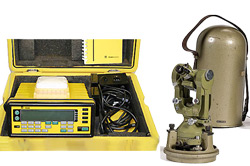In the late 1990s the majority of my surveying days were spent mapping cellular telephone towers. We got those contracts because of our willingness to commit to delivering the drawings and reports back to the client in less than a week. Our early adoption of GPS was the only thing that allowed us to do this. So, everyday I’d go out with three Trimble 4000 SEs and collect GPS data for the four or five hours that I had a sufficient constellation configuration to produce sub-meter results. (Probably the best job I ever had!) However, when it came time to determine the height of the tower I was given an old Wild T2 theodolite (w/ right angle prism) to use. This thing looked like it survived World War I, but just barely! It had come from Alaska and the fluid in the level bubbles had all been replaced with whale oil so it wouldn’t freeze during the winter up there. If you could get it to stay reading level during a 110° F summer day in Texas you had really done something! I’m not sure how old it was but I know that they stopped making that model before I was born.
The idea of taking something that old out on a job today strikes me as ludicrous. In fact, I have a hard time taking the first scanner we bought (Leica HDS 3000) out on a job; and it’s only six years old! It works as well as ever but when I consider the scan speed versus the newer scanners (and the giant batteries, laptop, etc.) I can’t do it. How am I supposed to compete with a guy scanning at 1,000,000 points a second with a unit the maxes out at 4,000 points per second? I’m comfortable with the ROI I received for that scanner but I’m far less confident going forward. The rate of introduction of new scanners as well as the improvements baked into to each new generation reminds me more of mobile phones than survey instruments. And I don’t think that I’m the only one.
Let’s consider the mobile phone analogy for a minute. Most of us (at least in the US) buy them through a service provider at a discount along with a two-year contract. We consider ourselves lucky if they still function well by the time we trade them in for a new one because while they are not quite disposable, they definitely have a finite lifespan. While I certainly expect a six-figure purchase to last more than two years, the reality is that, after three or four years ,scanners have been superseded by newer models such that their commercial lifespan is, in fact, over. So is the answer to quit buying scanners and lease them?
Personally, I can think of several scanner operators that have called me about renting my equipment that used to have their own scanners. Some still do, they just need a phase-based scanner for a particular job, or they need a second scanner for a particular project. But many of them say they don’t think they will buy another one. They just don’t see a way to get a good ROI before the unit is outdated. Even in our best years, our scanners spent a lot of days holding down a shelf. That is a real issue when you think about the expiration date of most of today’s scanners.
Even I find the thought of leasing rather tempting. Always having access to the latest and greatest scanners with current calibration reports and good batteries is a dream come true! Add to this the fact that the time necessary to scan something has decreased exponentially, and leasing sounds even better.
There are a few down sides to not owning your equipment, though. Because the scanner is never paid for, certain jobs will never be cost effective, as the equipment costs are not fungible. Training may also prove problematic. As we’ve discussed here before, skill to do comes of doing. The last is the software side of things. I don’t see how you could ever become proficient with any of the software packages used to process point cloud data without using them every day. If you are using it every day, then owning is obviously the best option.
It will be interesting to see how the market evolves over the coming years. The release of the Faro Focus 3D at a relatively low cost point led many of us to wonder if the short lifespan model was the coming wave. However, the other manufacturers seem to be holding steady with their pricing. We do have a lot more options when it comes to leasing than we did just a few years ago and the seemingly inevitable adoption of a format standard can only help.
In the end, I don’t think that forecasting the trend in this area correctly or incorrectly will “make or break” your company; but it might have a big effect on that Christmas bonus!






